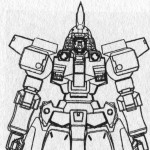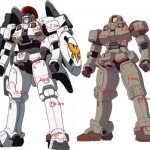Leo and Tallgeese Scaling Issue
By tetsujin on 2011-09-01 in Models
Tags: Gundam Wing, Leo, Tallgeese
Not a WIP sort of post but it’s an issue that interests me. In Gundam Wing there was a mass-produced mobile suit called “Leo”, as well as its larger, more powerful predecessor, known as the Tallgeese. The original Gundam Wing kit lines did include a Tallgeese, but the Leo was only available as a “Limited Model” kit – meaning both the availability and quality of the kit were limited. However, the two designs are very similar, and so for Leo fans, converting a Tallgeese model to a Leo is a tempting path. With the resurgence of Gundam Wing in MG form, there may even be a MG Tallgeese we can use. But since the Tallgeese is taller, that makes the resulting model out-of-scale… Or does it?
One common argument is that the Leo is not merely shorter, but scaled down in all dimensions. Often this image is presented to support the argument:
I don’t know the origin of this image, but on close inspection it does support the idea that the Leo really is a scale-down of the Tallgeese: Scale the Leo up by 7%, rotate it a bit, and it lines up with the Tallgeese perfectly:
So clearly this image does support the idea that the Tallgeese was scaled-down overall to make a Leo, and that a Tallgeese altered slightly and painted green to be a Leo will be out of scale. However, we must also consider why this particular image exists and what its origin is, and what it really means that the Leo in that image is a scale-down of the Tallgeese.
Line art for the designs used in mecha anime usually is not an orthographic front-view like this. Line art establishes the look of the machine rather than its exact dimensions. Since the animation process is not exact, or even very precise sometimes, having a drawing that shows dimensions is less useful than having a drawing that shows different sides of the machine in a style that can be used within the animation itself. Therefore it seems likely to me that this drawing exists solely for the purpose of establishing relative scale between the two machines, and that this image wasn’t meant as a visual reference for either machine. Also note that it’s the Tallgeese II that’s pictured, not the original Tallgeese: this suggests that the image was produced near the end of the production of Gundam Wing, after reference lineart for both Leo and the original Tallgeese had already been long-established. Finally, if you look at the details of the image, it looks very much like the 1:144 scale model kit. The hands, in particular, are a dead giveaway. This may mean that the Tallgeese II image was taken from design drawings for the model kit, and the Leo image was produced by scaling down the Tallgeese II image and changing some details. In conclusion, this drawing is not useful for establishing correct proportional information about either mobile suit. It was a rush job based on readily-available materials, made specifically and solely for the purpose of establishing scale.
The source line art is the best reference we have for determining the scale of the two MS. Based on examination of the line art, my first impression was that there were other differences between the two machines that could account for the height difference. In particular, the lower legs looked shorter. So I started with the assumption that an accurate Leo could be built from a Tallgeese kit, by removing height from a few key areas, and attempted to see if the lineart supported this assumption. The first task was to scale the two images to their proper size. Even this posed some challenges: the “Head Height” of the Tallgeese is 17.4m. Does that include the ornamentation on top of the head? I concluded that it doesn’t: all three Tallgeese have the same “head height” despite different ornamentation. This isn’t exactly conclusive, but it worked out pretty well so I went with it.
Measurements like these cannot be accurate in general: the drawings being measured are shown in perspective, and that perspective is not always rendered faithfully. What’s more, the perspective of the two drawings doesn’t match exactly. However, I think the measurements I’ve taken make a very strong case that the Leo is [i]not[/i] a scale-down. Most of the measurements through the upper body match within 5% of each other, and where they differ, they’re actually bigger on the Leo. If the 3.8m apparent width of the Tallgeese’s chest block were 6% smaller on the Leo, for instance, we’d expect to see the Leo’s chest block measurement be something like 3.6m or 3.5m – the difference would not be hidden by rounding. But this is not the case. The Leo’s chest block actually appears slightly wider than that of the Tallgeese.
Vertically, everything lines up very well from the top of the chest block down to the top of the legs. It’s only when we get down to the knees or up to the head that we see height differences.The shield on the “Early Type” Leo matches up very well with the size of the Tallgeese shield, as well.
In conclusion, I think the 1:100 Tallgeese-to-Leo height adjustments would be something like this:
- 4mm off the top of the head
- 3mm off the length of the upper leg
- 5mm off the length of the lower leg
That will create the required 12mm height difference in the models – though additional testing on the models may be required to see how that would look in practice.
It’s also interesting to note that the Leo arms appear a little bit stockier. I’m not sure if I would bother including that detail as part of a conversion, but it could be an interesting additional differentiation between the designs.






Post a Comment